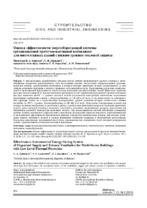| dc.contributor.author | Зафатаев, В. А. | |
| dc.contributor.author | Ланкович, С. В. | |
| dc.contributor.author | Королёва, Т. И. | |
| dc.contributor.author | Нияковский, А. М. | |
| dc.coverage.spatial | Минск | ru |
| dc.date.accessioned | 2022-04-06T13:16:17Z | |
| dc.date.available | 2022-04-06T13:16:17Z | |
| dc.date.issued | 2022 | |
| dc.identifier.citation | Оценка эффективности энергосберегающей системы организованной приточно-вытяжной вентиляции для многоэтажных зданий с низким уровнем тепловой защиты = Effectiveness Assessment of Energy-Saving System of Organized Supply and Exhaust Ventilation for Multi-Storey Buildings with Low Level Thermal Protection / В. А. Зафатаев [и др.] // Наука и техника. – 2022. – № 2. – С. 114-128. | ru |
| dc.identifier.uri | https://rep.bntu.by/handle/data/110961 | |
| dc.description.abstract | С использованием разработанного авторами метода технико-экономического расчета установок с теплообменными аппаратами рекуперативного типа исследованы режимы эксплуатации централизованной приточно-вытяжной системы организованной вентиляции, в которой подогрев приточного воздуха осуществляется за счет теплоты солнечного излучения и теплоты удаляемого из помещений воздуха. Представлены результаты оценки тепловой и экономической эффективности такой системы вентиляции для многоэтажных зданий. Выполнено сравнение расходов тепловой энергии на нужды отопления и вентиляции за счет применения предлагаемой системы вентиляции для двух вариантов зданий – с уровнем тепловой защиты ограждающих конструкций, отвечающим современным нормативным требованиям (здания с теплопотреблением до 130 кВтч/(м2год)), и для аналогичного по планировочной структуре здания, но с ограждающими конструкциями, уровень утепления которых соответствует зданиям постройки до 1993 г. (здания с теплопотреблением до 260 кВтч/(м2год)). Определены температурные условия, при которых возникает необходимость включения в работу устройств дополнительного (пикового) подогрева приточного воздуха, когда тепловой потенциал солнечного излучения и вторичных энергетических ресурсов недостаточен для обеспечения расчетной температуры приточного воздуха. Для рассматриваемой системы вентиляции установлено наличие влияния термических сопротивлений ограждающих конструкций здания на показатели термодинамической и экономической эффективности предлагаемого решения. Определены климатические условия, при которых утилизация теплоты удаляемого воздуха в системе вентиляции технически оправдана и экономически целесообразна. Результаты выполненных исследований могут быть использованы при определении путей тепловой модернизации зданий с традиционными системами отопления и вентиляции. | ru |
| dc.language.iso | ru | ru |
| dc.publisher | БНТУ | ru |
| dc.title | Оценка эффективности энергосберегающей системы организованной приточно-вытяжной вентиляции для многоэтажных зданий с низким уровнем тепловой защиты | ru |
| dc.title.alternative | Effectiveness Assessment of Energy-Saving System of Organized Supply and Exhaust Ventilation for Multi-Storey Buildings with Low Level Thermal Protection | ru |
| dc.type | Article | ru |
| dc.identifier.doi | 10.21122/2227-1031-2022-21-2-114-128 | |
| local.description.annotation | By usage of the technical and economic calculation method developed by the authors for installations with recuperative-type heat exchangers, the operational modes of the centralized supply and exhaust system of organized ventilation, in which the supplying air is heated by the solar radiation heat and the heat of the air removed from the premises, have been investigated in the paper. The paper presents results of the thermal and economic efficiency assessment of such ventilation system for multi-storey buildings. A comparison of the thermal energy consumption for the needs of heating and ventilation through the use of the proposed ventilation system has been made for two variants of buildings – with the thermal protection level of enclosing structures that meets modern regulatory requirements (buildings with heat consumption up to 130 kWh/(m2year)), and for a building similar in terms of planning structure, but with enclosing structures, the insulation level of which corresponds to buildings built before 1993 (buildings with heat consumption up to 260 kWh/(m2year)). The temperature conditions have been determined under which it becomes necessary to turn on the operation of devices for additional (peak) heating of the supply air, when the thermal potential of solar radiation and secondary energy resources is insufficient to provide the calculated temperature of the supply air. For the ventilation system under consideration, it has been established that the thermal resistance of the building envelope influences the indicators of the thermodynamic and economic efficiency of the proposed solution. The climatic conditions under which the utilization of the exhaust air heat in the proposed ventilation system is technically justified and economically expedient have been determined. The results of the research performed can be used for determination of the thermal modernization ways of buildings with traditional heating and ventilation systems. | ru |

